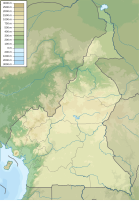Douala Edéa National Park
|
Douala Edéa National Park
|
||
|
Chimpanzees in Douala-Edéa National Park |
||
| location | Littoral region in Cameroon | |
| surface | 2,715.12 km² | |
| WDPA ID | 1244 | |
| Geographical location | 3 ° 29 ' N , 9 ° 51' E | |
|
|
||
| Setup date | 1932 | |
| administration | Cameroon Wildlife Conservation Society | |
The Douala Edéa National Park is a national park on the Atlantic coast of Cameroon . It is 2715 km² and is located south of Douala at a height of 0 to 50 m above sea level.
climate
There is a time of day climate . The dry season extends from November to March. The wettest month in the Douala area is July with an average rainfall of 725 mm; In December and January the monthly precipitation is lowest with 50 and 70 mm. In Mouanko falls in September with about 650 mm most rain. The annual precipitation is 3000 to 4000 mm. The average temperature around Douala is 26 ° C; in January it is 31 ° C, in July 21 ° C. In Mouanko, the average temperatures fluctuate between 24 and 29 ° C.
Vegetation and water
The vegetation consists mainly of primary rainforest , which is favored by the high annual rainfall. The area of the reserve is 80% tropical lowland forest and 15% Atlantic mangrove forest. There are also mangroves and seven lakes, including Tissongo Lake as the largest body of water and Osie Lake. The mangrove forests are mainly formed by red mangrove , Rhizophora harrisonii and Rhizophora racemosa as well as isolated sections of avicennia species (especially black mangrove ) and white mangrove together with nipa palms . The mouths of the Sanaga , Nyong , Dimbamba and Wouri rivers meet in the area of the national park. The Sanaga River forms the northern limit of the reserve.
fauna
There are numerous species of monkeys in the Douala-Edéa National Park, including Nigerian-Cameroon chimpanzee , lowland gorilla and Colobus satanas anthracinus . The collar specification was still considered common in 1972. The elephant population was still considered stable in 1985; In 2018 there was still a small population of forest elephants . The antelopes are represented by the bushbuck , sitatunga , black-backed duiker , white-bellied duiker , blue-backed duiker , Petersducker , yellow-bridged duiker and Batesbuck . The small-clawed finger otter may also live in the national park. There are also crocodiles, green sea turtles , Cameroon river dolphins and small populations of the African manatee , leatherback turtle and olive ridged turtle . The hawksbill sea turtle also nests here. Over 70 species of waterfowl have been recorded, including the Lesser Flamingo , and there are also many migratory birds such as the black-winged curlew and the gape-beak . The Sanaga River is home to 135 species of fish, including 21 endemic species .
History of the protected area
In 1932 the Douala-Edea Faunal Reserve (French Réserve de faune de Douala-Edéa ) was set up as a game reserve with a size of 1600 km², from 9 ° 31 'to 10 ° 05'E and on the instructions of the Haut-commissaire de la République française lying from 3 ° 14 'to 3 ° 53'N. Since the 1930s there have been villages within the reserve's boundaries that have primarily engaged in fishing, with mangrove wood being used to smoke the fish. More than 8,000 people now live in the more than 60 villages, including many immigrant fishermen. In 2018 the reserve received the status of a national park and was expanded to 2,715.12 km². The newly added areas contain mangrove forests, rivers, swamps and marine areas.
literature
- Gordon Nwutih Ajonina: Inventory and modeling Mangrove Forest Stand Dynamics Following Different Level of Wood Exploitation Pressure in the Douala-Edea Atlantic Coast of Cameroon, Central Africa (PDF, 4.8 MB), Dissertation, 2008.
- Wally and Horst Hagen: The African national parks as habitats for elephants. In: Vitus B. Dröscher : Save the elephants of Africa. 1st edition. Goldmann, Munich 1992, ISBN 3-442-12322-4 , pp. 215-216.
Web links
- World Database on Protected Areas - Douala-Edea National Park (English)
- Mboa Guide: La Réserve de Faune Douala Edea (French) ( Memento from September 24, 2016 in the Internet Archive )
Individual evidence
- ↑ Peter Ngea: Douala - Edea Reserve: the last refuge of hope for man and nature (Part 2) . EnviroMend, October 19, 2010.
- ↑ Littoral as a travel destination ( page no longer available , search in web archives: tkvoyages.com (English) )
- ↑ Brief description of the reserve (English) ( Memento of 25 September 2009 at the Internet Archive )
- ↑ Phyllis C. Lee: Threatened Primates of Africa: The IUCN Red Data Book . IUCN 1988. ISBN 2-88032-955-8 . P. 17.
- ^ Franck Alary, François Moutou and Hélène Jacques: Still on the Tracks of the Congo Clawless Otter (Aonyx congicus): First Mission in Cameroon (English), IUCN Otter Specialist Group, April 2002.
- ↑ Cameroon Wildlife Conservation Society: Charismatic Sea Turtle Populations in Peril, Douala-Edea National Park (English), March 9, 2020.
- ^ A b Rainforest Trust: Cameroon's First Marine & Terrestrial National Park Announced (English), October 15, 2018.
- ↑ Edith Brown Weiss, Harold Karan Jacobson: Engaging countries: strengthening compliance with international environmental accords . MIT Press 2000. ISBN 0-262-73132-0 . P. 447.
- ↑ Gordon Nwutih Ajonina: Inventory and modeling Mangrove Forest Stand Dynamics Following Different Level of Wood Exploitation Pressure in the Douala-Edea Atlantic Coast of Cameroon, Central Afrika , 2008, pp. 62f. (English; PDF, 4.8 MB)

